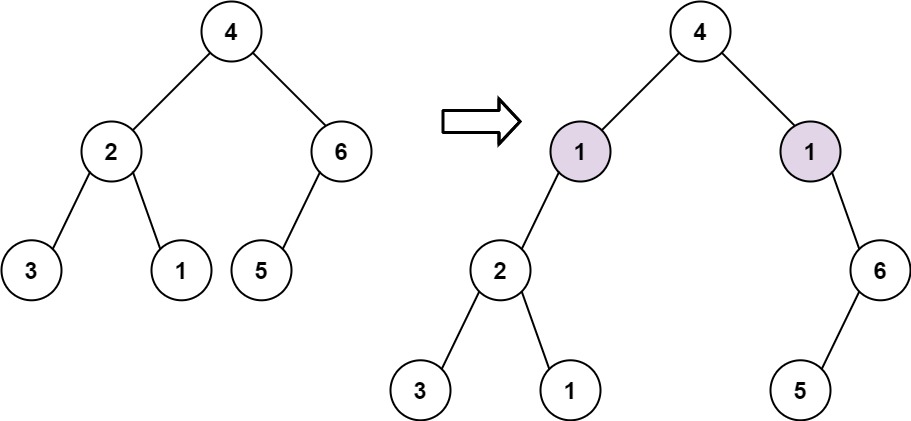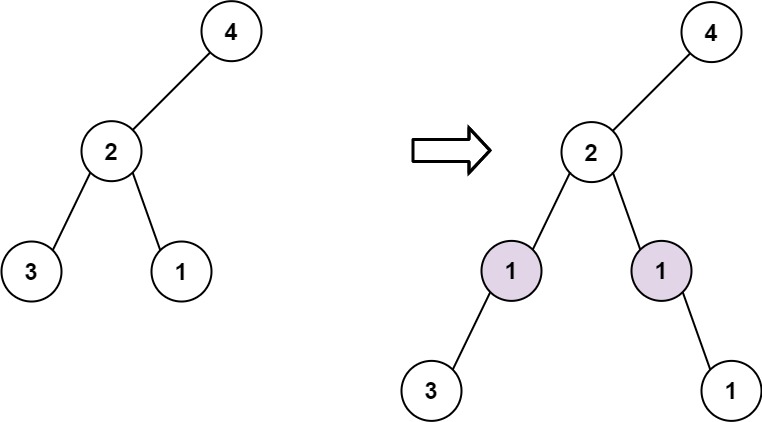Topic
- Tree
Description
https://leetcode.com/problems/add-one-row-to-tree/
Given the root of a binary tree and two integers val and K, add a row of nodes with value val at the given depth depth.
Note that the root node is at depth 1.
The adding rule is:
-
Given the integer
depth, for each not null tree nodecurat the depthdepth - 1, create two tree nodes with valuevalascur's left subtree root and right subtree root. -
cur's original left subtree should be the left subtree of the new left subtree root. -
cur's original right subtree should be the right subtree of the new right subtree root. -
If
depth == 1that means there is no depthdepth - 1at all, then create a tree node with valuevalas the new root of the whole original tree, and the original tree is the new root’s left subtree.
Example 1:

Input: root = [4,2,6,3,1,5], val = 1, depth = 2
Output: [4,1,1,2,null,null,6,3,1,5]
Example 2:

Input: root = [4,2,null,3,1], val = 1, depth = 3
Output: [4,2,null,1,1,3,null,null,1]
Constraints:
- The number of nodes in the tree is in the range [ 1 , 1 0 4 ] [1, 10^4] [1,104].
- The depth of the tree is in the range [ 1 , 1 0 4 ] [1, 10^4] [1,104].
- − 100 < = N o d e . v a l < = 100 -100 <= Node.val <= 100 −100<=Node.val<=100
- − 1 0 5 < = v a l < = 1 0 5 -10^5 <= val <= 10^5 −105<=val<=105
- 1 < = d e p t h < = t h e d e p t h o f t r e e + 1 1 <= depth <= the\ depth\ of\ tree + 1 1<=depth<=the depth of tree+1
Analysis
方法一:BFS
方法二:DFS
Submission
import java.util.LinkedList;
import com.lun.util.BinaryTree.TreeNode;
public class AddOneRowToTree {
//方法一:BFS
public TreeNode addOneRow(TreeNode root, int val, int depth) {
if(depth == 1) {
return new TreeNode(val, root, null);
}
LinkedList<TreeNode> queue = new LinkedList<>();
queue.offer(root);
int level = 1;
while(!queue.isEmpty()) {
++level;
for(int size = queue.size(); size > 0; size--) {
TreeNode node = queue.poll();
if(level == depth) {
node.left = new TreeNode(val, node.left, null);
node.right = new TreeNode(val, null, node.right);
}else {
if(node.left != null)
queue.offer(node.left);
if(node.right != null)
queue.offer(node.right);
}
}
}
return root;
}
//方法二:DFS
public TreeNode addOneRow2(TreeNode root, int val, int depth) {
if(depth == 1) {
return new TreeNode(val, root, null);
}
addOneRow2(root, val, depth, 1);
return root;
}
private void addOneRow2(TreeNode node, int val, int depth, int level) {
if(node == null) return;
if(++level == depth) {
node.left = new TreeNode(val, node.left, null);
node.right = new TreeNode(val, null, node.right);
return;
}
addOneRow2(node.left, val, depth, level);
addOneRow2(node.right, val, depth, level);
}
}
Test
import static org.junit.Assert.*;
import org.junit.Test;
import com.lun.util.BinaryTree;
import com.lun.util.BinaryTree.TreeNode;
public class AddOneRowToTreeTest {
@Test
public void test() {
AddOneRowToTree obj = new AddOneRowToTree();
TreeNode root1 = BinaryTree.integers2BinaryTree(4, 2, 6, 3, 1, 5);
TreeNode expected1 = BinaryTree.integers2BinaryTree(4, 1, 1, 2, null, null, 6, 3, 1, 5);
assertTrue(BinaryTree.equals(obj.addOneRow(root1, 1, 2), expected1));
TreeNode root2 = BinaryTree.integers2BinaryTree(4, 2, null, 3, 1);
TreeNode expected2 = BinaryTree.integers2BinaryTree(4, 2, null, 1, 1, 3, null, null, 1);
assertTrue(BinaryTree.equals(obj.addOneRow(root2, 1, 3), expected2));
TreeNode root3 = BinaryTree.integers2BinaryTree(1, 2, 3, 4);
TreeNode expected3 = BinaryTree.integers2BinaryTree(1, 2, 3, 4, null, null, null, 5, 5);
assertTrue(BinaryTree.equals(obj.addOneRow(root3, 5, 4), expected3));
}
@Test
public void test2() {
AddOneRowToTree obj = new AddOneRowToTree();
TreeNode root1 = BinaryTree.integers2BinaryTree(4, 2, 6, 3, 1, 5);
TreeNode expected1 = BinaryTree.integers2BinaryTree(4, 1, 1, 2, null, null, 6, 3, 1, 5);
assertTrue(BinaryTree.equals(obj.addOneRow2(root1, 1, 2), expected1));
TreeNode root2 = BinaryTree.integers2BinaryTree(4, 2, null, 3, 1);
TreeNode expected2 = BinaryTree.integers2BinaryTree(4, 2, null, 1, 1, 3, null, null, 1);
assertTrue(BinaryTree.equals(obj.addOneRow2(root2, 1, 3), expected2));
TreeNode root3 = BinaryTree.integers2BinaryTree(1, 2, 3, 4);
TreeNode expected3 = BinaryTree.integers2BinaryTree(1, 2, 3, 4, null, null, null, 5, 5);
assertTrue(BinaryTree.equals(obj.addOneRow2(root3, 5, 4), expected3));
}
}






















 168
168











 被折叠的 条评论
为什么被折叠?
被折叠的 条评论
为什么被折叠?








